It's time to explain why aerated concrete is the most right material for walls country house and no other material can compete with it in terms of the totality of characteristics. I propose to consider together all the existing this moment on the market Construction Materials(including rare and exotic) and make sure that better material than aerated concrete for low-rise construction do not invent.
But in any case, from wooden wall materials frame house is the best thing to choose in our time. Thus, we actually get that with all the variety of existing building materials, we are left with only two options:
house from cellular concrete(aerated concrete)
Frame house
All other building materials, in principle, are not consistent and it makes no sense to consider them if you are building a house for the long term for long-term and comfortable operation. And now is the time to make a direct comparison of a house made of aerated concrete and a frame.
To choose suitable materials it is important to understand how your home was built. When carrying out repairs, be careful when using compatible materials. Traditional buildings used soft, weakly permeable materials such as lime mortars. Later modern building, on the other hand, uses durable impervious materials such as cement and concrete. If you use modern materials with traditional construction, you can simply do more damage by trapping moisture and reducing permeability.
Let me remind you that in both cases we focus on the fact that the house will be built on a monolithic foundation slab, that is, the low heat capacity of the walls frame house not relevant in our case. If you decide to build a frame house on a pile foundation, then soberly understand that the heat capacity of such a house will tend to zero and any shutdown of heating in winter will lead to almost instant freezing of the whole house. When it comes to home permanent residence and year-round operation, it must have an extremely high heat capacity of enclosing structures, tk. it is on this parameter that the comfort of operating such a house directly depends.
If you are looking to make repairs to your home, you may need a permit and you should seek advice, especially if your home is listed or in a nature reserve. When choosing new materials for such repairs, they must comply with original materials as close as possible. They must comply not only with appearance, but also by physical properties so that they react the same way over time.
The identical materials used for the renovation may initially provide a new contrast to the existing building fabric. But over time, they will sympathize sympathetically, so it's better to do that than try to match the weathering using spare materials. The cleanup of derelict buildings should not be encouraged to provide demand for salvaged materials.
The main advantage of a frame house is the ability to get an incredibly “warm” wall at a minimum cost. This is directly related to the fact that for light insulation, the resistance to heat transfer per centimeter of thickness is 2-3 times less than that of solid wood or even aerated concrete.
The second predominantly frame houses- the speed of erection of the supporting frame of walls and roofs. In fact, the advantage is rather doubtful if you approach the house as a complex object. Because the subsequent finishing of the frame house, firstly, will no longer be so fast, and secondly, with engineering systems will also have to tinker. But if you want to get a roof over your head here and now (it doesn’t matter that you still have to work and work under this roof so that the house finally looks like a house), then you can also agree to a frame house. The same applies to the recently popular modular houses assembled in production. Their manufacturers position the assembly in the hangar as an advantage for the customer, although in fact the customer should not care at all, because. This does not affect the production time in any way. But for the performer, the assembly under the roof of the hangar is a big plus, because. allows to reduce costs and downtime associated with the unpredictability of the weather, if we consider the option of building on the customer's site. But on the other hand, the customer becomes severely limited by the too small dimensions of individual modules, which are completely uncomfortable for subsequent operation (for example, ceilings in normal house must be at least 2.8 meters).
If source identical materials are not possible, try using the most similar ones. Otherwise, you might approach the repair differently. Using modern materials can sometimes be a solution if it means, in the long run, preserving more original historical material. For example, using of stainless steel Renovating a historic roof will allow you to retain more of the original timber than a traditional roof renovation.
Everything repair work, however they run should avoid the need for intensive maintenance as it is likely to be difficult to maintain. Previous repairs should be treated with respect and should not be touched unless they work.
This is where the advantages of frame houses end and the disadvantages begin.
First, and most important. Frame houses are now being built by everyone who is not too lazy (because the cost of building a frame house is extremely low and you can “weld” well), which requires special control over compliance with construction technology. Otherwise, you can get such a barn, which will collapse at the slightest gust of wind. According to the link in the video, everything that could be violated was violated, but in fact, during a hurricane with very highly likely and a well-built frame house will collapse to one degree or another, and one must be prepared for this. The calculation of loads for a frame house must be done more carefully than for a stone house, paradoxical as it may seem.
Concrete wall construction
There is currently wide range suppliers various kinds materials for traditional construction: lime for mortars; hair for plaster; clay tiles; and wattle to fill panels in wood-framed buildings. Details can be found in specialized catalogs such as the Building Conservation Handbook.
Greenhouse framing requires a second billing of the material used as siding, but the wrong frame material can mean an unstable structure that will never square, making assembly difficult, as well as creating drafts and openings for pests and critters.
The second disadvantage of frame houses is expensive finishing and laying of engineering systems. open way. Indeed, in combustible structures it is forbidden to lay electrical wiring, and therefore it will have to be carried out in an open way, which is very doubtful from an aesthetic point of view. In a house made of cellular concrete, everything is much simpler - all communications and wires are laid in the walls, which are then plastered. Absolutely the same as they do in apartments.
Many times you don't have a choice for framing, but here are some considerations while you shop around your greenhouse. Wood, like glass, is beautiful but impractical unless you're really looking for a tanning bed. Wood goes well with insulation and ease of assembly, but greenhouses are damp, damp chipped and the wood warps and rots. If you have wood available, choose mahogany, cedar, or specially treated wood and print.
Aluminum has a low content: it does not rust or break down from exposure to the elements. But he is not very strong, and the support must be large or doubled. But it provides a good rigid shape for glass or polycarbonate and can be painted or anodized in any color.
By the way, about ventilation. If you “forget” to do it in an aerated concrete house, then the high vapor permeability of the walls will allow you to somehow cope with excess moisture in the house, and frame house-thermos without ventilation with a microclimate, everything will be very bad.
What else?
The sound insulation of a frame house is just as bad as that of an unplastered cellular concrete house.
Hanging heavy objects on the walls is possible only on load-bearing frame.
Mice and other pests can start in the walls of a frame house.
Fire hazard. stone houses also burn, but extremely rarely this leads to the collapse of walls and ceilings. The frame house burns down instantly, despite various impregnations for wood (remember that the electrician in the frame house can only be carried out in an open way).
The durability of a frame house rests on the service life wooden frame(and without protection, the tree will begin to rot). While stone building materials (including cellular concrete) are eternal, cement-based materials only become stronger over the years.
Galvanized steel provides durability at a low cost. Due to its strength, less physical equipment is required, so there is less shade in the greenhouse. However, most steel frames are designed for use with plastic wrap. The big negative for galvanized steel is that the galvanization will eventually wear out and the steel will rust.
Plastic also offers limited heat loss. Another disadvantage is that the frame is large to make up for its lack of strength and can cast shadows. Advantages of straw construction. Straw bales are made from waste. After edible part grain is harvested, the stalks often become a problem for farmers. Replenishing the straw, new matter is given new life. The farmer makes money by selling bales, while the house builder gets excellent insulation and building materials.
If we compare completely finished houses the same area, with engineering systems and finishing, a surprising discovery can be made. The cost of work and materials for a frame house is almost identical to the cost of work and materials for building a house from aerated concrete. Of course aerated concrete house it will turn out a little more expensive, because. during its construction, mechanization will be required, but this will be less than 10% of the total cost of all work.
Straw bale walls are at least 18 inches thick. This adds aesthetic value to the home as thick walls are expensive to achieve conventional construction. Wall thickness helps reflect sunlight throughout the room. Due to the thickness of the walls of the straw bales, each window may have a saddle or a shelf. It becomes both an aesthetic and practical design element.
The concept of straw bale construction is easy to understand even for beginner builders. Under the supervision of one knowledgeable straw bale trainer, ace builders can assist in the construction process. Not only does this spread the word about building thatch, it means the homebuilder can save money by using a team of volunteers to help raise the walls.
Thus, we can conclude that aerated concrete is an ideal building material, which has no alternatives in principle. A frame house should be considered only if, for one reason or another, you do not have the opportunity to build a house from cellular concrete.
In the next part, we will choose the perfect roof for a country house. Don't switch!
Straw bales have low embodied energy. This means that very little energy was used to produce the product, as sunlight was the main source of energy for the growing plant. The only energy needed to make a straw bale is the process of mining and transporting to the workbench. Other insulating materials, such as fiberglass, require a significant amount of energy to produce.
Straw bales are 100% biodegradable - when the time is right. Straw bale houses can last over 100 years if maintained properly. At some point, all structures will eventually be replaced. When the time comes, straw bales can be plowed onto the ground. On the other hand, fiberglass becomes a recycling problem.
Brick, usually considered a traditional building material for building the walls of a house.
But today, in the construction market of materials for building walls at home, there are materials that are much lighter, with good thermal insulation properties and most importantly, cheaper, such materials for building the walls of a house include cellular concrete.
Straw bale walls can be cut with a knife or chainsaw. Openings around windows or doors can be rolled up to a nice radius. Bales can also be brought to a sharp corner edge. Despite what may seem logical, properly constructed straw bale walls have proven to be more fire resistant than conventional construction. wooden frame. This is because the bales are dense and tend to simply smolder when the source of ignition is removed.
Straw bale houses can be beautiful as the natural material lends itself to several architectural styles. Straw design flaws. While not difficult, they are different. If construction straws are not part of your local codes, it may be a little more to get your plans approved. Contact other professionals in your area and see if they can suggest local architects or engineers who are used to working with natural materials, and see how they can churn out your plans and help with the approval process.
Gas-silicate, gas-concrete, foam-silicate materials for the construction of house walls belong to the same class of building materials - cellular building materials.
Cellular concrete, which seems to have appeared on the construction market not so long ago, is rapidly gaining popularity. Cellular concretes differ from one another in the materials used for their manufacture and in the method of production, cellular concretes belong to the group of light building materials for the construction of house walls.
cinder block house
The walls of the straw bale must be dry, as moisture is not only bad for the straw, but also for many building materials. Moisture entering the bales from the roof above should be avoided at all costs. If your straw bale walls stay dry, they will last a lifetime in the building.
Areas of extreme humidity and rain are not suitable for thatch construction. Due to the thickness of the walls, more than your square footage will be unusable due to it being inside the wall. Concrete is the material that literally holds our cities together. from houses and apartment buildings on bridges, viaducts and sidewalks, the importance of this ubiquitous gray material for modern urban life is undeniable. But you may have heard that he also has a dirty secret: the production of commercial concrete materials releases tons of carbon dioxide into the atmosphere every year, contributing to the disaster that is.
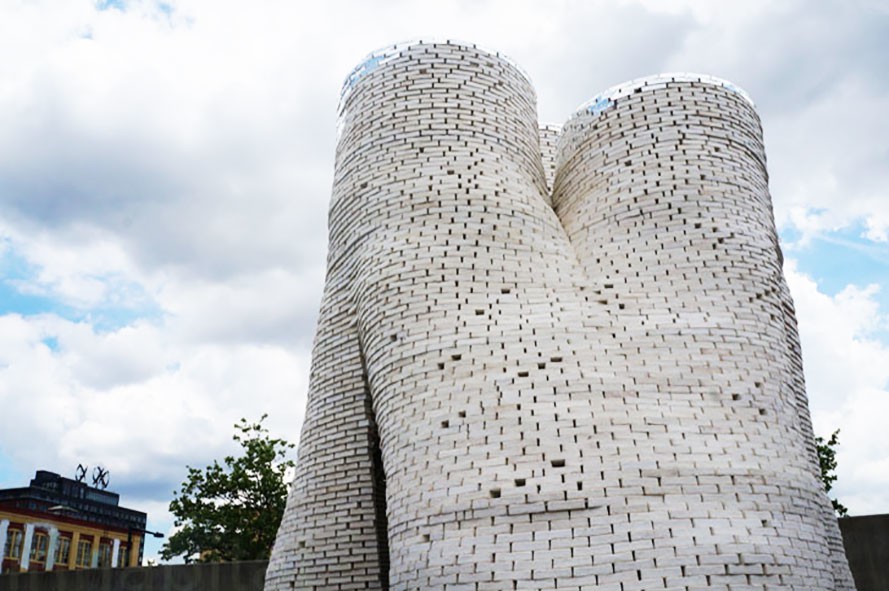
Foam concrete is a simple solution of cement, to which special surface-active components are added, which cause it to foam, which is performed mechanically. Due to foaming, the mass of concrete is saturated with air bubbles and a cellular structure appears. These foam concrete cells are completely airtight and saturated with air. A huge number of such cells create excellent sound-heat insulating properties and lightness for foam concrete. It is possible to produce foam concrete of different densities by changing the composition of the mixture for the manufacture of foam concrete - from 400 to 1800 kg / m3. In this case, it is possible to increase the strength of foam concrete, but at the same time, the heat transfer resistance will decrease.
Wall units made of ceramic materials
But it shouldn't be like that. We've rounded up 11 green building materials that offer alternatives to concrete and have a lower environmental impact. environment. Instead of relying on new research and technology, straw bale construction dates back to a time when houses were built from natural, locally found materials. Straw bales are used to create internal walls inside the frame, replacing other building materials such as concrete, wood, gypsum, gypsum, fiberglass, or stone.
In appearance, foam concrete from the inside resembles foam concrete - porous chocolate, outwardly similar to a simple gray stone. Foam concrete blocks are made in sizes: 600 x 300 x 250 mm and 600 (length) x 300 (height) x 200 (width) mm. There are foam concrete blocks for the construction of partitions inside the house, with a width of 50 to 600 mm.
According to the type of application, building materials from cellular concrete can be divided into the following types: structural and heat-insulating, heat-insulating and structural. For construction load-bearing structures buildings, blocks of cellular concrete with a density of at least D 500 are used, and for inlays with a density of D 400.
When properly sealed, straw bales naturally provide a very high level insulation for hot or cold climates and are not only affordable but sustainable as straw is a rapidly renewable resource. 
This is a crazy futuristic building material that is actually completely natural - it includes the root structure of mushrooms and mushrooms. Mycelium can be encouraged to be grown along with other natural materials such as chopped straw in molds or moulds, then air dried to create light and strong bricks or other shapes.
Cellular concrete won its popularity mainly due to its physical properties. Aerated concrete for the construction of house walls has the same thermal insulation properties as wood - from 0.12 to 0.4 W / (m K), it can be compared, pine has thermal insulation properties of 0.14 W / (m-K). Building foam concrete materials are light - this indicator significantly reduces the foundation.
What determines the soundproofing properties of a wall?
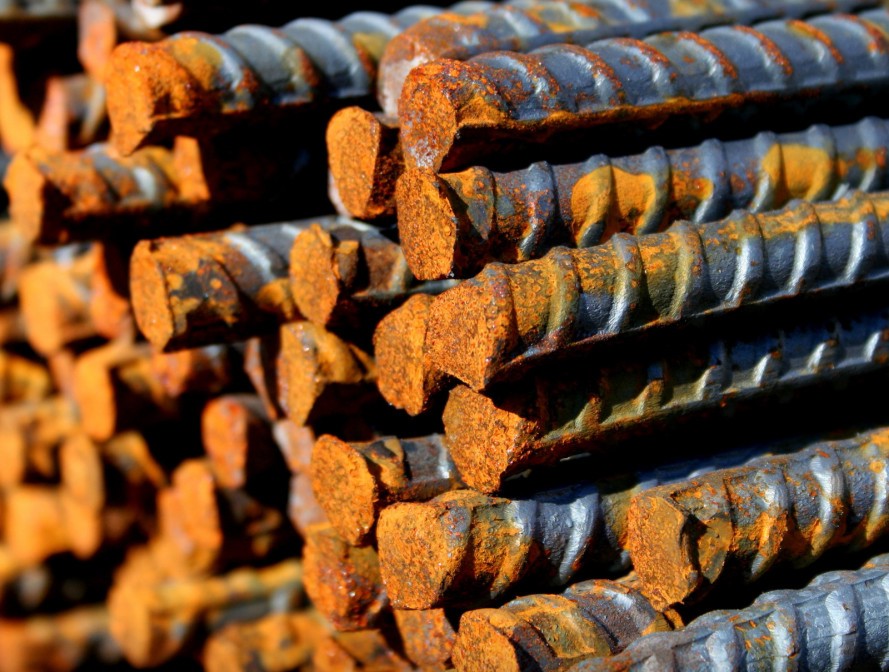

Using fly ash by-product burning coal, 97 percent of the traditional components in concrete can be replaced with recycled material. 
Because it is lighter than concrete, it reduces transport emissions, and sawdust recycles waste and replaces some of the energy intensive components of traditional concrete.
Foam concrete can be easily processed, it perfectly resists high temperatures, is resistant to temperature extremes, frost-resistant, durable, environmentally friendly, has vapor permeability, and has good adhesion. The walls of a house built of cellular concrete will have many times more thermal insulation than, for example, brick ones.
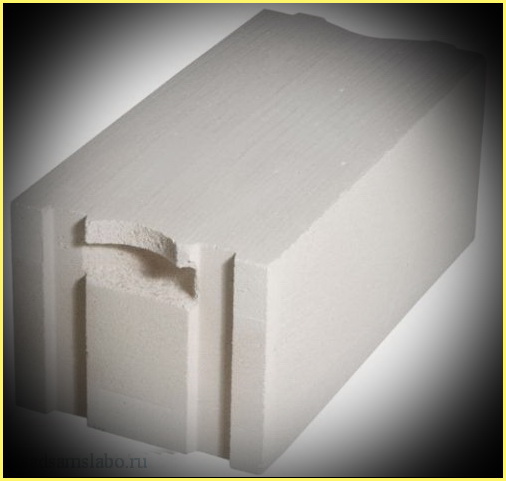
Aerated concrete building materials are resistant to fire, are not subject to rotting and corrosion, are easy to work with (they are easy to process, easy to mill, drill, chisel). It has even edges, a smooth surface. Aerated concrete building materials have such quality properties as good thermal conductivity, which is higher than that of building materials such as silicate and ceramic materials, excellent water absorption and vapor permeability. 2 times more reliable, with the same density. For the construction of the walls of the house, one is enough aerated concrete block having a thickness of 37.5 cm.
Construction of houses using cellular concrete
Cellular concrete has unique properties, which create the opportunity to build houses throughout the year. It is a pleasure to build a house using this building material, not expensive, easy and quite fast, because one block of cellular concrete replaces a whole bunch of standard bricks (a block with dimensions of 60 x 30 x 20 cm is equal to 16 bricks). This type building material for the construction of walls are easy to process, with a simple hacksaw they can be given any desired shape,
Such products are easy to process using a simple hacksaw, this building material can be given any shape, so you can build a building of any complexity and shape, create arches and rounded surfaces, and when installing windows and doors in openings, it is easy to choose a quarter. For the construction of houses, cellular concrete with a density of 400-500 kg / m3 is used, at which cellular concrete is perfectly combined.
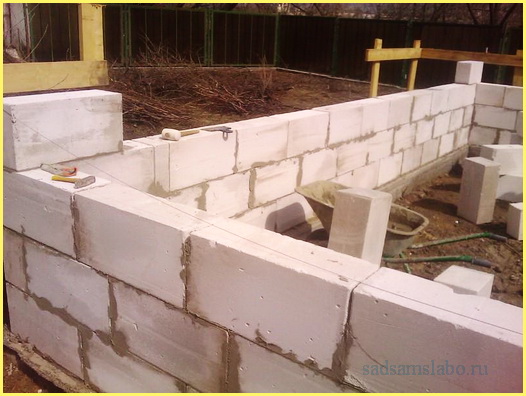
In order to prevent the appearance of cold bridges, it is advisable to lay cellular concrete on special glue, and not on cement-sand mortar. When a cement-sand mortar is used for masonry walls, water goes into the block and the seam becomes insufficiently reliable due to lack of moisture. To increase the strength of the masonry, it is possible to moisten the blocks with water before erecting the wall, and perform the masonry itself on a thick layer cement-sand mixture, the wall will turn out to be strong, but with this option of laying the walls, cold bridges are formed. When using glue, a ready-made dry mix, to which are added special preparations which retain water. When using glue, the laying of cellular concrete is obtained - thermally more homogeneous, and the seam is thinner. To complete the laying of the walls of a house of 1 m3, it will take about 40 kg of glue. The cost of twenty kilograms of glue fluctuates within twenty US dollars.

Construction of the walls of the house - monolithic construction
There is another method of building a house using cellular concrete, non-autoclaved (foam concrete), using a monolithic removable formwork, building a house in this way will require less finance, and will cost 1.5-2 times cheaper. Building a house with this method can only be done at a temperature not lower than +10 ° C and for construction a special installation is needed to make foam, it mixes the foam with a cement solution and transports the resulting mass through a hose to the construction site of the house.
To build the walls of the shape we need, fiberboard (fibreboard) is used for removable formwork, but for the construction of walls and partitions, you can also use fixed formwork, which is made of fiberboard and brick, but the construction of the walls of the house, using fixed formwork, will require more money. Formwork can be made by construction, from two sides brick walls and pour concrete mixture between them. Another formwork construction method, you can build a brick wall with only outer side, and with inside, fix drywall or fiberboard boards. Fiberboard or GKL, leaving a foam concrete surface inside, can then be dismantled. In the future, you can proceed to finish the walls by gluing tiles, painting ...
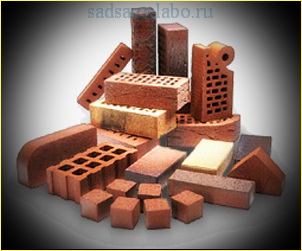
When building the walls of a brick house, they breathe, as natural materials are used to make bricks. natural materials. Brick has excellent sound and heat insulation properties, it is a durable and resistant to biological and weathering building material. In terms of environmental properties, brick is ahead of only wood, it is easy to work with brick, it is perfectly combined with building materials made of metal, concrete, stone, glass. During the construction of the walls of the house from solid ceramic brick, it takes a lot of time and labor, you need to make thermal insulation of the walls, it takes a large number of cement mortar. Well, as for the traditional silicate brick, which mainly consists of water, lime and sand, it is not very environmentally friendly, absorbs moisture and is a rather heavy building material.
To eliminate all of the above disadvantages, when building the walls of a house, you can use porous ceramic blocks, which are slightly more expensive than a brick, but much better. The parameters of a brick determine its technologically correct use.
Ceramic bricks come in sizes: in the form of blocks with dimensions of 25 x 12 x 25 cm and more, single 25x12x6.5 cm, one and a half - 25 x 12 x 8.8 mm., Double - 25 x 12 x 25 cm. The brand of ceramic brick is indicated by the letter M (M 100, M 125), which this letter means the strength of the brick. The number after the letter indicates the pressure that 1 cm2 of the surface of the material can withstand without collapsing. The weight of a brick depends on the brand, the higher the brand, the heavier the brick.
As a percentage, the water-absorbing ability of a brick is characterized, to absorb moisture. For the construction of the outer walls of the house, it is desirable to use a brick with low water-absorbing properties. The frost resistance of a brick is indicated by the letter F (F 25, F 50). The thermal conductivity coefficient of a brick depends on the structure and density. The thermal conductivity coefficient for facing ceramic bricks should be -0.36-0.5 W / (m K), porous ceramic blocks - 0.09-0.18 W / (m-K), clinker bricks 0.8 W / ( m-K). The thickness of the wall depends on the value, the higher it is, the thicker the wall of the house should be to preserve heat.
What material to choose
Choosing today a building material for erecting the walls of a house, between brick and cellular concrete, you need to carefully consider their aesthetic, energy-saving and economic properties. Today, thanks to the development of technology, the aesthetic and operational qualities of bricks have greatly increased. It is possible to build brick walls using the lightweight and solid masonry method. To build a wall using the continuous masonry method, in order to save heat, the wall must be insulated or have a thickness of at least 1.9 m. thermal insulation layers, can be no more than 400-500 mm. By building the walls of the house using cellular concrete, you will save 30-40% on heating without spending money on heat-insulating materials. When building the walls of the house from cellular concrete, you will also save not only money, but also time.
Construction of house walls - microclimate
The microclimate in a house built of cellular concrete is very similar to the microclimate in wooden house. In a house built of cellular concrete, fungus and mold do not appear, because this building material has a higher vapor permeability than brick and can regulate the humidity in the room. Cellular concrete and bricks have a capillary structure, these building materials absorb water from the air and soil, but since the walls of houses built from these materials are subject to finishing that protects them from external atmospheric influences, they do not have high water absorption requirements.
It is not advisable to finish the walls of a house built of cellular concrete with clinker or facing bricks for facades, these building materials have a high density and low vapor permeability. The fact is that between brick and bearing wall, there must be a gap. Finishing the facade of the house, which is made closely, does not allow steam to leave the premises of the house, as a result, dampness forms on the walls inside the house.
Construction of the walls of the house from cellular concrete - foundation
When building a foundation for a house built of cellular concrete, you need Special attention draw on strength. Aerated concrete is not very durable. For example, if small foundation movements are allowed for houses built of brick or wood, then with such movements, a house built of cellular concrete will crack.

